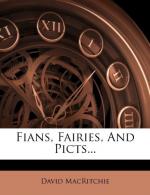[Footnote 42: Hibbert’s “Description of the Shetland Islands,” Edinburgh, 1822, pp. 444-451. With regard to the “Dwarfie Stone” of Hoy, the following references may be given:—“Jo. Ben,” 1529, at p. 449 of Barry’s “History of the Orkney Islands,” 2nd ed., London, 1808; and other writers subsequent to 1529. These speak of this stone as the abode of a “giant.” Sir Walter Scott (The Pirate, Note P.) and many others invariably say “a dwarf.”
Note also J.F. Campbell (W.H. Tales, p. xcix): “The Highland giants were not so big, but that their conquerors wore their clothes.” Also the dwarf in Ramsay’s “Evergreen” who says that he was engendered “of giants’ kind.”]
[Footnote 43: Dean of Lismore’s Book, p. lxxvi.; Celt. Scot., vol. i. p. 131; vol. iii. chap. iii.; &c.]
[Footnote 44: Celt. Scot. iii. 106-7.]
[Footnote 45: In this tale, the phonetic spelling ben-ce shows the unusual aspirated form bean-shithe. She is elsewhere spoken of as the Lady of Innse Uaine, and her son is the hero of the tale Gille nan Cochla-Craicinn.]
[Footnote 46: According to a clergyman of the seventeenth century, the Hebrides and a part of the Western Highlands constituted “the country of the Fians,” (Testimony of Tradition, p. 45.)]
[Footnote 47: Miss Dempster: “The Folk-Lore of Sutherlandshire,” Folk-Lore Journal, vol. vi. 1888, p. 174.]
[Footnote 48: Proc. of the Soc. of Antiq. of Scot., vol. vii. p. 294.]
[Footnote 49: Proc. Soc. Antiq. Scot., vol. vii. pp. 165 and 192.]
[Footnote 50: “They are plainly no other than the Peihts, Picts, or Piks ... the Scandinavian writers generally call the Piks Peti, or Pets: one of them uses the term Petia, instead of Pictland (Saxo-Gram.); and, besides, the frith that divides Orkney from Caithness is usually denominated Petland Fiord in the Icelandic Sagas or histories.” (Barry’s Orkney, p. 115.)]




